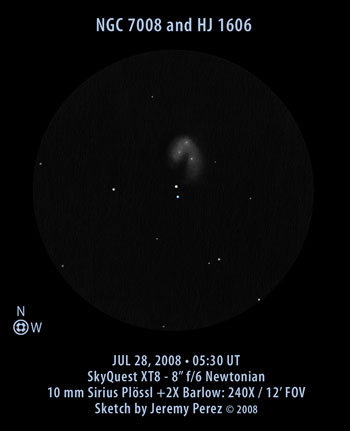Observation Notes:
This fascinating planetary nebula was pleasantly large, and easy to spot with my low power eyepiece at 37.5X. I could see no color in the nebula, but there was some color right next to it in the double star HJ 1606. The primary of this double was a subtle, warm ivory, while the secondary was blue. The nebula had a comma or ear-like shape, formed by a dark intrusion entering from the south-southeast. It also appeared lumpy and enmeshed with faint stars. Those stars gave an initial impression of a highly unresolved open cluster. What appeared to be three stars at first, turned out to be only two. After some examination of astrophotos, the northernmost “star” appears to be a highly condensed bright spot in the nebula. A look at Wes Stone’s gallery shows that he too detected this area as star-like in this excellent sketch: NGC 7008 – Wes Stone
I measured the double star at a PA of 183° and a separation of 18.9 arc seconds. The Washington Double Star catalog lists a 1901 value of 185° and 18.4 arc seconds.
This colorful double, and fascinating, unusually shaped planetary nebula make for a great pair to observe on a warm summer night.
Object Information:
NGC 7008 was discovered by Friedrich Wilhelm Herschel in 1787. It is also cataloged as: PK93+5.2, H I-192, h 2099, GC 4627
| Subject | NGC 7008 HJ 1606 |
| Classification* | NGC 7008: Planetary Nebula (3) HJ 1606: Double Star |
| Position* | NGC 7008: Cygnus [RA: 21:00:32.8 / Dec: +54:32:35] HJ 1606: Cygnus [RA: 21:00:35.3 / Dec: +54:31:45] |
| Size* | NGC 7008: 97″ x 75″ |
| Brightness* | NGC 7008: 10.7 vMag HJ 1606: A: 9.3 / B: 10.2 |
| Position Angle | HJ 1606: 183° [my measurement 2008.5] 185° [WDS 1901] |
| Separation | HJ 1606: 18.9″ [my measurement 2008.5] 18.4″ [WDS 1901] |
| Date/Time | July 27, 2008 – 10:30 PM MST (July 28, 2008 – 5:30 UT) |
| Observing Loc. | Flagstaff, Arizona, USA – Home |
| Instrument | Orion SkyQuest XT8 (203 mm dia./1200 mm F/L) |
| Eyepieces/Mag. | 10 mm Sirius Plössl + 2X Barlow (240X) |
| Conditions | Partly cloudy, breezy |
| Seeing | 3/10 Pickering |
| Transparency | ~ Mag 6.0 NELM |
| *References | NGCIC.org, The Washington Visual Double Star Catalog, 1996.0 (Worley+, 1996); Catalog of Stellar Spectral Classifications (Skiff, 2007) |
